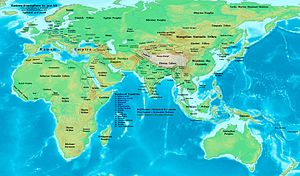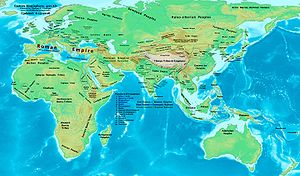
4th century
Did you know...
This Schools selection was originally chosen by SOS Children for schools in the developing world without internet access. It is available as a intranet download. Child sponsorship helps children one by one http://www.sponsor-a-child.org.uk/.
| Millennium: | 1st millennium |
|---|---|
| Centuries: |
|
| Decades: | 300s 310s 320s 330s 340s 350s 360s 370s 380s 390s |
| Categories: | Births – Deaths Establishments – Disestablishments |
As a means of recording the passage of time, the 4th century (per the Julian calendar and Anno Domini/ Common era) was that century which lasted from 301 to 400.
Overview
In the West, the early part of the century was shaped by Constantine I, who became the first Roman emperor to convert to Christianity. Gaining sole reign of the empire, he is also noted for re-establishing a single imperial capital, choosing the site of ancient Byzantium in 330 (over of the current capitals, which had effectively been changed by Diocletian's reforms to Milan in the West, and Nicomedia in the East) to build the city soon called Nova Roma (New Rome); it was later renamed Constantinople in his honour.
The last emperor to control both the eastern and western halves of the empire was Theodosius I. As the century progressed after his death it became increasingly apparent that the empire had changed in many ways since the time of Augustus. The two emperor system originally established by Diocletian in the previous century fell into regular practice, and the east continued to grow in importance as a centre of trade and imperial power, while Rome itself diminished greatly in importance due to its location far from potential trouble spots, like Central Europe and the East. Late in the century Christianity became the official state religion, and the empire's old pagan culture began to disappear. General prosperity was felt throughout this period, but recurring invasions by Germanic tribes plagued the empire from AD 376 onward. These early invasions marked the beginning of the end for the Western Roman Empire.
According to archaeologists, sufficient archaeological correlates of state-level societies coalesced in the 4th century to show the existence in Korea of the Three Kingdoms (AD 300/400–668) of Baekje, Goguryeo, and Silla.
Events

- Early 4th century – Former audience hall now known as the Basilica, Trier, Germany, is built.
- 301: Armenia first to adopt Christianity as state religion.
- 306 – 337: Constantine I, ends persecution of Christians in the Roman Empire (see also Constantinian shift) and Constantinople becomes new seat of government ( New Rome)
- 325- 328: The Kingdom of Aksum adopts Christianity.
- 325: Constantine I calls the First Council of Nicaea to pacify Christianity in the grip of the Arian controversy.
- 337: Constantine I is baptized on his death bed
- 350: About this time the Kingdom of Aksum conquers the Kingdom of Kush
- 350: About this time the Huns begin to invade the Sassanid Empire.
- Mid-4th century – Dish, from Mildenhall, England, is made. It is now kept at The British Museum, London.
- Mid-4th century - Wang Xizhi makes a portion of a letter from the Feng Ju album. Six Dynasties period. It is now kept at National Palace Museum, Taipei, Taiwan, Republic of China.
- 376: Visigoths appear on the Danube and are allowed entry into the Roman Empire in their flight from the Huns.
- 378: Battle of Adrianople. Roman army is defeated by Visigoth cavalry. Emperor Valens is killed.
- 378 – 395: Theodosius I, Roman emperor, bans pagan worship, Christianity is made the official religion of the Empire.
- 381: First Council of Constantinople reaffirms the Christian doctrine of the Trinity by adding to the creed of Nicaea.
- 383: Battle of Fei River in China
- 395: Roman Emperor Theodosius I dies, causing the Roman Empire to split permanently.
- Late 4th century – See "The Historia" of Arbogast and Bauto.
- Late 4th century – Cubiculum of Leonis, Catacomb of Commodilla, near Rome, is made.
- Late 4th century – Atrium added in Old St. Peter's Basilica, Rome.
Significant people
- Ambrose, Christian theologian, bishop of Milan.
- Augustine, Christian theologian, bishop of Hippo.
- Basil the Great, Christian theologian, bishop of Caesarea in Cappadocia.
- Constantine I, (306-337), Roman emperor.
- Diocletian, Roman Emperor.
- Ephrem the Syrian, (c. 306–373), Syriac speaking deacon, hymnographer, theologian, director of the School of Edessa.
- Ezana Aksumite Emperor.
- Fa-Hsien, Chinese Buddhist monk.
- Gregory of Nazianzus, (c.329- c.390), Christian theologian, bishop of Nazianzus in Cappadocia.
- Iamblichus, (245-c. 325), Neoplatonist philosopher.
- Jerome, Christian priest, monk, and translator of the Bible into Latin.
- John Chrysostom, Syrian-born Patriarch of Constantinople.
- Kumārajīva, ( 344- 413), Buddhist monk from India, translator of sutras into Chinese.
- Lactantius (c.240 – c.320) Christian theologian, advisor to Constantine I.
- Mesrop Mashtots, (c. 361–c.440), Armenian monk, theologian and inventor of the Armenian alphabet.
- Tao-un (312-385), Chinese Buddhist monk, translator who elimnates Taoist words from Buddhist writings.
- Theodore, (c. 350–428), Christian theologian, bishop of Mopsuestia.
- Theodosius I (378-395), Roman Emperor.
- Ulfilas, Arian priest and translator of the Bible into Gothic.
Inventions, discoveries, introductions
- The stirrup was invented in China, no later than 322
- Kama Sutra
- Codex Sinaiticus, Codex Vaticanus Graecus 1209, earliest Christian bibles
- Book of Steps, Syriac religious discourses
Decades and years
|
|||||||||||||||||||||||||||||||||||||||||||||||||||||||||||||||||||||||||||||||||||||||||||||||||||||||||||||||||||||||||||||||||||||||||
|
|||||||||||||||||||||||||||||||||||||||||||||||||||||||||||||||||||||||||||||||||||||||||||||||||||||||||||||||||||



